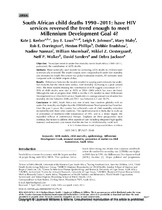| dc.contributor.author | Kerber, Kate J. | |
| dc.contributor.author | Lawn, Joy E. | |
| dc.contributor.author | Sanders, David | |
| dc.contributor.author | Jackson, Debra | |
| dc.contributor.author | Johnson, Leigh F. | |
| dc.contributor.author | Maye, Mary | |
| dc.contributor.author | Dorrington, Rob E. | |
| dc.contributor.author | Phillips, Heston | |
| dc.contributor.author | Bradshaw, Debbie | |
| dc.contributor.author | Nannan, Nadine | |
| dc.contributor.author | Msemburi, William | |
| dc.contributor.author | Oestergaard, Mikkel Z. | |
| dc.contributor.author | Walker, Neff P. | |
| dc.date.accessioned | 2017-07-04T07:06:33Z | |
| dc.date.available | 2017-07-04T07:06:33Z | |
| dc.date.issued | 2013 | |
| dc.identifier.citation | Kerber, K. J. et al. (2013). South African child deaths 1990-2011: have HIV services reversed the trend enough to meet Millennium Development Goal 4? AIDS, 27 (16): 2637–2648 | en_US |
| dc.identifier.issn | 0269-9370 | |
| dc.identifier.uri | http://hdl.handle.net/10566/3033 | |
| dc.description.abstract | OBJECTIVE: To analyse trends in under-five mortality rate in South Africa (1990–2011),
particularly the contribution of AIDS deaths.
METHODS: Three nationally used models for estimating AIDS deaths in children were
systematically reviewed. The model outputs were compared with under-five mortality
rate estimates for South Africa from two global estimation models. All estimates were
compared with available empirical data.
RESULTS: Differences between the models resulted in varying point estimates for underfive
mortality but the trends were similar, with mortality increasing to a peak around
2005. The three models showing the contribution of AIDS suggest a maximum of 37–
39% of child deaths were due to AIDS in 2004–2005 which has since declined.
Although the rate of progress from 1990 is not the 4.4% needed to meet Millennium
Development Goal 4 for child survival, South Africa’s average annual rate of under-five
mortality decline between 2006 and 2011 was between 6.3 and 10.2%.
CONCLUSION: In 2005, South Africa was one of only four countries globally with an
under-five mortality rate higher than the 1990 Millennium Development Goal baseline.
Over the past 5 years, the country has achieved a rate of child mortality reduction
exceeded by only three other countries. This rapid turnaround is likely due to scale-up
of prevention of mother-to-child transmission of HIV, and to a lesser degree, the
expanded roll-out of antiretroviral therapy. Emphasis on these programmes must
continue, but failure to address other aspects of care including integrated high-quality
maternal and neonatal care means that the decline in child mortality could stall. | en_US |
| dc.language.iso | en | en_US |
| dc.publisher | Lippincott Williams & Wilkins | en_US |
| dc.rights | Publisher retains copyright. This is an open-access article distributed under the terms
of the Creative Commons Attribution-NonCommercial-NoDerivitives 3.0 License, where it is permissible to download and share the work
provided it is properly cited. The work cannot be changed in any way or used commercially. | |
| dc.source.uri | http://dx.doi.org/10.1097/01.aids.0000432987.53271.40 | |
| dc.subject | AIDS models | en_US |
| dc.subject | Child mortality | en_US |
| dc.subject | Epidemiology | en_US |
| dc.subject | Millennium development goals | en_US |
| dc.subject | Neonatal mortality | en_US |
| dc.subject | Prevention of mother-to-child transmission | en_US |
| dc.subject | South Africa | en_US |
| dc.title | South African child deaths 1990-2011: have HIV services reversed the trend enough to meet Millennium Development Goal 4? | en_US |
| dc.type | Article | en_US |
| dc.description.accreditation | Department of HE and Training approved list | |

